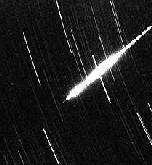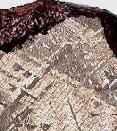

A Meteor is a luminous trail in the sky produced when a meteoroid burns up in the atmosphere. It is commonly referred to as a "shooting star". Sometimes many meteoroids may hit the atmosphere around the same time, giving us a meteor shower.
So what's a Meteoroid?
This refers to the particle itself without relation to the phenomena
it produces when entering the Earth's atmosphere (a meteor).
A meteoroid is matter revolving around the sun or any object in
interplanetary space that is too small to be called an asteroid or a
comet. Even smaller particles are called micro-meteoroids or cosmic dust
grains, which includes any interstellar material that should happen to
enter our solar system. A meteoroid becomes a meteorite if it
survives its plunge through the atmosphere and reaches the surface of
the earth.
Meteorites
Most meteorites come from
asteroids, including a few believed to have come
specifically from 4 Vesta (one of the largest asteroids
in our solar system). A few probably
come from comets. Of the 10s of thousands known,
a very small number of meteorites have
been shown to be of Lunar (23 finds)
or Martian (perhaps as many as 18) origin. The largest known
meteorites are about the size of a telephone booth. But
there is clear evidence that even larger objects have
hit earth in the past.
 Though meteorites may appear to be just boring rocks, they are
extremely important in that we can analyze them carefully in our labs.
Aside from the few kilos of moon rocks brought back by the Apollo and
Luna missions, meteorites are our only material evidence
of the universe beyond the Earth.
Though meteorites may appear to be just boring rocks, they are
extremely important in that we can analyze them carefully in our labs.
Aside from the few kilos of moon rocks brought back by the Apollo and
Luna missions, meteorites are our only material evidence
of the universe beyond the Earth.
Composition of Meteorites
Basically, there are two kinds of meteorites: Iron (about
4.8% of meteorites found) and Stony (about 94%).
Stony Meteorites
being the most common, also have a bit more variety. there are
three sub-classifications of stonys: Chondrites, containing
chondrules, Carbonaceous Chondrites, containing chondrules
along with volatile minerals and Achondrites which contain
no chondroles.
Then, there is a final very rare kind of mixed meteorite, referred to as
Stony-Iron (about 1.2%).
 Iron Meteorites
Iron Meteorites
These meteorites are made of a crystalline iron-nickel
alloy. Scientists believe that they resemble the
outer core of the Earth.
Widmanstatten Patterns (shown to the left) are seen in iron meteorites. This pattern is made up of two metals. These two alloys of Nickel and Iron crystalize at slightly different temperatures. So slightly that the cooling rate has to be about 1 degree per million years in order for this pattern to emerge. This could only happen in the molten core of a planet, and serves as proof that these objects could not have come from the earth.